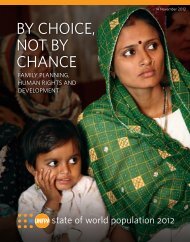2. Get InformedWhere?Of all health indica<str<strong>on</strong>g>to</str<strong>on</strong>g>rs tracked by the World <strong>Health</strong> Organizati<strong>on</strong> (WHO), maternalmortality shows the greatest disparity between rich and poor countries: 99 percen<str<strong>on</strong>g>to</str<strong>on</strong>g>f women who die during pregnancy and childbirth are in the developing world. 18births per 1,000 Adolescent girls aged 15-19 19more than 150100.1 – 15050.1 – 100less than 50no dataIn developing countries each year…• 215 milli<strong>on</strong> women who want <str<strong>on</strong>g>to</str<strong>on</strong>g> avoid pregnancy do not use an effectivemethod of c<strong>on</strong>tracepti<strong>on</strong>. 20• Nearly half of pregnant women give birth without the assistance ofa skilled provider. 21• 20 milli<strong>on</strong> women have unsafe aborti<strong>on</strong>s. 22• 10 <str<strong>on</strong>g>to</str<strong>on</strong>g> 20 milli<strong>on</strong> women suffer severe or l<strong>on</strong>g-lasting illnesses or disabilitiescaused by complicati<strong>on</strong>s during pregnancy and childbirth. 23• 50 milli<strong>on</strong> pregnant women are exposed <str<strong>on</strong>g>to</str<strong>on</strong>g> malaria, c<strong>on</strong>tributing <str<strong>on</strong>g>to</str<strong>on</strong>g> severematernal anemia, miscarriage, and babies with low birthweight. 24• 1.5 milli<strong>on</strong> HIV positive women give birth in developing countries.Pregnancy is associated with an elevated risk of c<strong>on</strong>tracting HIV, whileHIV/AIDS can raise pregnant women’s risk of hemorrhage, sepsis, andother complicati<strong>on</strong>s. 25• C<strong>on</strong>flict, natural disasters, and other crises displace women—includingpregnant women and women who become pregnant while displaced.While their chances of attaining care have increased, the vast majoritygive birth without the medical care they need. 26Probability relative <str<strong>on</strong>g>to</str<strong>on</strong>g> mothers 24 <str<strong>on</strong>g>to</str<strong>on</strong>g> 26 years old*2.52.01.5HypertensiveDisordersWhy? 1.08%ObstructedLaborEnsuring women’s and girls’ health is a human right. <strong>Maternal</strong> health is central0.528% Other13%<str<strong>on</strong>g>to</str<strong>on</strong>g> women’s overall health, and women’s health affects every<strong>on</strong>e: healthy womenUnsafe Aborti<strong>on</strong>c<strong>on</strong>tribute <str<strong>on</strong>g>to</str<strong>on</strong>g> the health and well-being of their children, families, communities, and0.0MORTALITY UNDERWEIGHT STUNTING DIARRHEA ANEMIAnati<strong>on</strong>s. And every<strong>on</strong>e has a role <str<strong>on</strong>g>to</str<strong>on</strong>g> play in ensuring that their health is a priority. 27DEVELOPA GLOBAL PLAN FORDEVELOPMENT8.• Policy makers must have thepolitical will <str<strong>on</strong>g>to</str<strong>on</strong>g> enact policiesand allocate funds <str<strong>on</strong>g>to</str<strong>on</strong>g> improvematernal health.1.ERADICATEEXTREMEPOVERTY• Communities shape social andcultural norms that support or5.detract from women’s ability <str<strong>on</strong>g>to</str<strong>on</strong>g>IMPROVEclaim their rights. All membersMATERNALof communities—not just theHEALTHmost powerful—should beinvolved in efforts <str<strong>on</strong>g>to</str<strong>on</strong>g> m<strong>on</strong>i<str<strong>on</strong>g>to</str<strong>on</strong>g>rand evaluate policies, <str<strong>on</strong>g>to</str<strong>on</strong>g> mobilizepolitical will, and <str<strong>on</strong>g>to</str<strong>on</strong>g> define gapsin health service coverage.ENSUREENVIRONMENTALSUSTAINABILITY7.ACHIEVEUNIVERSAL PRIMARYEDUCATIONCOMBAT AIDS/HIV,MALARIA AND OTHERDISEASES6.2.REDUCECHILDMORTALITYPROMOTE GENDEREQUALITY ANDEMPOWER WOMEN4.AGE OF MOTHERAT FIRST BIRTH12-14• <strong>Health</strong> care providers can helpprovide safe spaces for eventhe most marginalized women and girls <str<strong>on</strong>g>to</str<strong>on</strong>g> get the care they need byshowing respect and sensitivity <str<strong>on</strong>g>to</str<strong>on</strong>g> the needs and c<strong>on</strong>cerns of theirpatients.• Local, regi<strong>on</strong>al, nati<strong>on</strong>al, and internati<strong>on</strong>al media can raise awarenessof an issue, project, or initiative and c<strong>on</strong>nect pers<strong>on</strong>al s<str<strong>on</strong>g>to</str<strong>on</strong>g>ries andstatistics.• Family members—including male family members—can promoteequitable gender norms at home.3.Comprehensive soluti<strong>on</strong>s are attainable—and urgent.<strong>Health</strong> systems that work for girls work for every<strong>on</strong>e: not <strong>on</strong>ly are they proven<str<strong>on</strong>g>to</str<strong>on</strong>g> reach girls, who are am<strong>on</strong>g the most socially vulnerable, and easily excludedgroups, but they are also likely <str<strong>on</strong>g>to</str<strong>on</strong>g> be equipped with the resources, skills, andsupplies needed <str<strong>on</strong>g>to</str<strong>on</strong>g> provide all levels of care. 2815-1718-20PROVIDERS12%Eclampsia &POLICY MAKERSHEALTH CARE15%SepsisFAMILY MEMBERSCOMMUNITIES& INTERNATIONAL MEDIA24%HemorrhageLOCAL, REGIONAL, NATIONAL7
2. Get Informed8HOW TO SAVE GIRLS’ AND WOMEN’S LIVESThree health systems strategies have been proven <str<strong>on</strong>g>to</str<strong>on</strong>g> improve girls’ and women’schances of surviving pregnancy, childbirth, and the critical days after the end of apregnancy: 29123Access <str<strong>on</strong>g>to</str<strong>on</strong>g> voluntary family planningWhat it is: Counseling <str<strong>on</strong>g>to</str<strong>on</strong>g> ensure that women, and couples make informedchoices regarding c<strong>on</strong>tracepti<strong>on</strong>; medical care/services supporting thosedecisi<strong>on</strong>s; and appropriate supplies, such as c<strong>on</strong>traceptive pills, emergencyc<strong>on</strong>traceptives, and c<strong>on</strong>doms.Why it matters: Ensuring girls, women, and their male partners have access <str<strong>on</strong>g>to</str<strong>on</strong>g>family planning enables them <str<strong>on</strong>g>to</str<strong>on</strong>g> avoid high-risk and unintended pregnancies.Access <str<strong>on</strong>g>to</str<strong>on</strong>g> quality care for pregnancy and childbirth (antenatalcare; skilled attendance at birth, including emergency obstetricand ne<strong>on</strong>atal care; and immediate postnatal care for mothersand newborns, at delivery and in the postpartum period)What it is: Antenatal care includes counseling <str<strong>on</strong>g>to</str<strong>on</strong>g> prepare women for birthand recognize complicati<strong>on</strong>s and services <str<strong>on</strong>g>to</str<strong>on</strong>g> treat syphilis, prevent mother<str<strong>on</strong>g>to</str<strong>on</strong>g>-childtransmissi<strong>on</strong> of HIV, provide tetanus vaccinati<strong>on</strong>s, and intervene <str<strong>on</strong>g>to</str<strong>on</strong>g>benefit both mothers and newborns. Skilled care during labor and at deliveryincludes 24-hour access <str<strong>on</strong>g>to</str<strong>on</strong>g> skilled birth attendants, such as doc<str<strong>on</strong>g>to</str<strong>on</strong>g>rs, nurses,and midwives for normal deliveries, and referrals for obstetric emergencies.Immediate postnatal care for mothers and newborns includes m<strong>on</strong>i<str<strong>on</strong>g>to</str<strong>on</strong>g>ring ofexcessive bleeding, pain, and infecti<strong>on</strong>; counseling <strong>on</strong> breastfeeding, familyplanning, and nutriti<strong>on</strong>; and newborn care, including identificati<strong>on</strong> of dangersigns and treatment or referral for complicati<strong>on</strong>s.Why it matters: 42 percent of pregnancies everywhere in the world involveserious complicati<strong>on</strong>s. Skilled care makes the difference between life and death.Access <str<strong>on</strong>g>to</str<strong>on</strong>g> safe aborti<strong>on</strong>, when legalWhat it is: Medical or surgical procedures <str<strong>on</strong>g>to</str<strong>on</strong>g> terminate an unwanted pregnancy,in accordance with the laws of a given country. Services must be provided bywell-trained pers<strong>on</strong>nel, with access <str<strong>on</strong>g>to</str<strong>on</strong>g> appropriate equipment and supplies andsupported by the health system infrastructures, policy, and regulati<strong>on</strong>s thatensure safety.Why it matters: Unsafe aborti<strong>on</strong>s account for 13 percent of deaths associatedwith pregnancy and childbirth.THREE DELAYS 30Once complicati<strong>on</strong>s occur, women’s survival depends <strong>on</strong> whether they are able <str<strong>on</strong>g>to</str<strong>on</strong>g>get the care that they need. Three delays raise women’s risk of dying:1. Delay in seeking care: <strong>Women</strong> and girls may have <str<strong>on</strong>g>to</str<strong>on</strong>g> get permissi<strong>on</strong>from husbands or parents, and women and their families may notrecognize the emergency; some may fear hospital practices. Youngwomen often experience further delays because of stigma of youngwomen’s sexuality and gender-based violence.2. Delay in reaching an emergency care facility: Transportati<strong>on</strong> may beunavailable or unaffordable or take <str<strong>on</strong>g>to</str<strong>on</strong>g>o l<strong>on</strong>g.3. Delay in receiving care from providers: Richer patients or males maybe seen first and facilities may lack staff, equipment or supplies. Inadditi<strong>on</strong>, care may be unaffordable.Taking <str<strong>on</strong>g>Acti<strong>on</strong></str<strong>on</strong>g> for Sustainable Change<strong>Women</strong> <strong>Deliver</strong> has outlined a global acti<strong>on</strong> plan 31 for governments andthe internati<strong>on</strong>al community <str<strong>on</strong>g>to</str<strong>on</strong>g> commit <str<strong>on</strong>g>to</str<strong>on</strong>g>:• Increase investment in maternal, newborn, and reproductive health,calling for an additi<strong>on</strong>al US $12 billi<strong>on</strong> in 2010, increasing annually <str<strong>on</strong>g>to</str<strong>on</strong>g> anadditi<strong>on</strong>al US $20 billi<strong>on</strong> in 2015.• Strengthen health systems <str<strong>on</strong>g>to</str<strong>on</strong>g> scale up health interventi<strong>on</strong>s and fillgaps—including 2.5 milli<strong>on</strong> health care professi<strong>on</strong>als (midwives, nurses,doc<str<strong>on</strong>g>to</str<strong>on</strong>g>rs, and specialists) and managers.• Strengthen maternal, newborn, and reproductive health programsand instituti<strong>on</strong>s—ensuring that services and informati<strong>on</strong> areaccessible and delivered with respect for women—especially poor andmarginalized women and adolescents.• Develop m<strong>on</strong>i<str<strong>on</strong>g>to</str<strong>on</strong>g>ring and accountability mechanisms and channels forcommunity engagement that address wider socioec<strong>on</strong>omic, political,and cultural barriers <str<strong>on</strong>g>to</str<strong>on</strong>g> care, and help improve policies and programs.Young leaders like you will make the difference when it comes <str<strong>on</strong>g>to</str<strong>on</strong>g> sharing keymessages, engaging communities, and persuading leaders <str<strong>on</strong>g>to</str<strong>on</strong>g> invest in women andgirls. Your commitment, energy, and the ec<strong>on</strong>omic, social/cultural, political, andtechnological soluti<strong>on</strong>s you define are needed at every level.
















